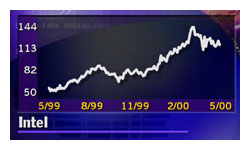|
Intel hot with flash memory
|
 |
May 22, 2000: 4:07 p.m. ET
Chipmaker says it made its one-billionth sale of memory chips
By Staff Writer Richard Richtmyer
|
NEW YORK (CNNfn) - Amid explosive demand for wireless communications and other portable electronics devices, Intel on Monday marked its one-billionth sale of the memory chips that are integral to those products.
Intel (INTC: Research, Estimates) first started selling the chips, called flash memory, 12 years ago. And executives at the Santa Clara-based chip giant said they expect to sell a billion more by 2002.
"The big news really is that, because flash is an integral part of cellular phones and those are shipping in such high volume, the next billion units is only going to take two years to get to," Curt Nichols, general manager of Intel's flash products group, said in an interview Monday.
 Flash chips hold their data even when the devices they are used in are powered down, unlike the memory used in personal computers. That makes flash ideal for use in wireless phones and other portable devices such as handheld computers and digital audio players. Flash chips hold their data even when the devices they are used in are powered down, unlike the memory used in personal computers. That makes flash ideal for use in wireless phones and other portable devices such as handheld computers and digital audio players.
Because of the explosive growth in the popularity of these devices recently, demand for flash chips far outstrips the available supply, a scenario that most observers expect to continue at least through the remainder of this year.
"There's no question that the demand for flash far exceeds supply today," Nichols said. "How long that will continue is anybody's guess. Cellular phones are growing at a phenomenal rate. The whole wireless industry has experienced growth that no analyst has correctly projected."
To keep pace with the surging demand, Intel is investing very heavily in its flash memory business, according to Nichols.
Last month, Intel chief executive, Craig Barrett, said the company will spend roughly $6 billion this year to expand its manufacturing capacity, with roughly 20 percent of that earmarked for flash products.
The company in February bought a manufacturing facility in Colorado Springs, Colo., which is dedicated to flash-memory production. "That facility, when it is fully built out is going to take $1.5 billion in investments, and the lion's share of that is going to happen this year," Nichols said.
Intel also is in the process of moving all of its flash-memory manufacturing to a 0.18-micron manufacturing process from a 0.25-micron process, which yields more chips for each silicon wafer produced.
"It basically allows us to double the number of flash chips we get on every wafer," Nichols said. "It's a huge advantage in terms of being able to supply the industry with more chips."
Intel, which began shipping chips manufactured on the 0.18-micron process last month, expects to have all of its facilities fully converted over 12 months, Nichols said.
New Xeon chips rolled out
Separately, Intel on Monday rolled out the latest versions of its Pentium III Xeon microprocessors, which are designed for use in network servers.
The new chips -- which operate at 700 megahertz, compared with their 550 MHz predecessors -- also are manufactured on the 0.18-micron process. Intel said the new Xeon chips will boost overall system performance anywhere from 13 to 46 percent, depending on the applications and system configurations.
Key to the boost in performance is an element of the new chips' design, which integrates the processor's cache with the chip itself. A microprocessor's cache is a memory bank that bridges main system's main memory and the central processor. The prior Xeons used a separate cache chip.
The new chips are currently shipping in limited quantities, priced at $1,177 for the one-megabyte cache version and $1,980 for the two-megabyte cache version.
Stock bounces back
Intel shares, which traded lower for the better part of the day, recovered in a late-afternoon rally, finishing 1/2 higher at 118-3/8.
On Friday, Intel shares slid sharply on news that the company had restated its most recent quarterly financial results.
 In documents filed with the Securities and Exchange Commission last Thursday, Intel reduced its first-quarter earnings-per-share by a penny and lowered its total sales by $28 million, which it said reflects the financial impact of a defective chipset that was shipped with printed circuit boards during the period. In documents filed with the Securities and Exchange Commission last Thursday, Intel reduced its first-quarter earnings-per-share by a penny and lowered its total sales by $28 million, which it said reflects the financial impact of a defective chipset that was shipped with printed circuit boards during the period.
In the filing, Intel reported first-quarter sales of $7.99 billion, revised down from $8.02 billion, and net income of $2.7 billion, or 77 cents. The pretax impact of the revision on profit was $53 million, the company said.
Analysts on Friday said the real cost for Intel is going to be in replacing the faulty parts. Even so, most said the problem would have a minimal financial impact on Intel, which is the world's largest supplier of computer chips.
Intel has fared reasonably well in the shakeout in tech stocks that has been taking place since March. Though down roughly 20 percent from their 12-month high of 145-3/8 that they reached in March, Intel shares still stand well above their 12-month low of 50-1/8 reached last summer. 
|
|
|
|
|
 |

|

